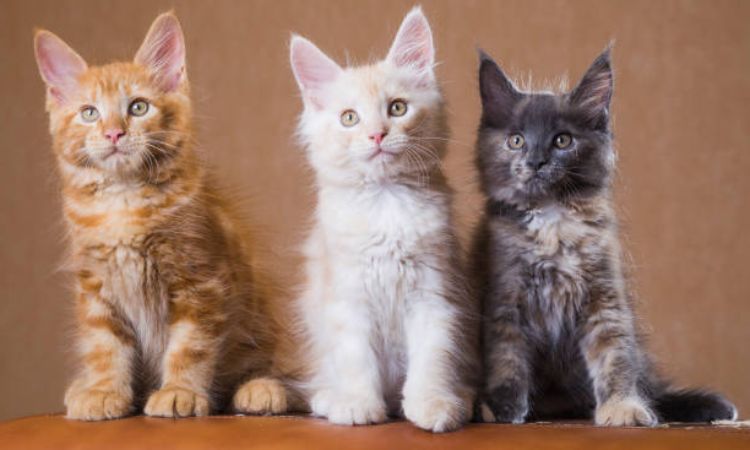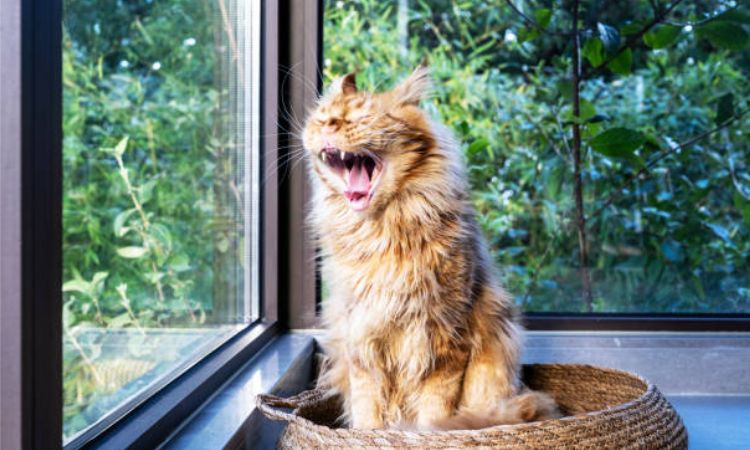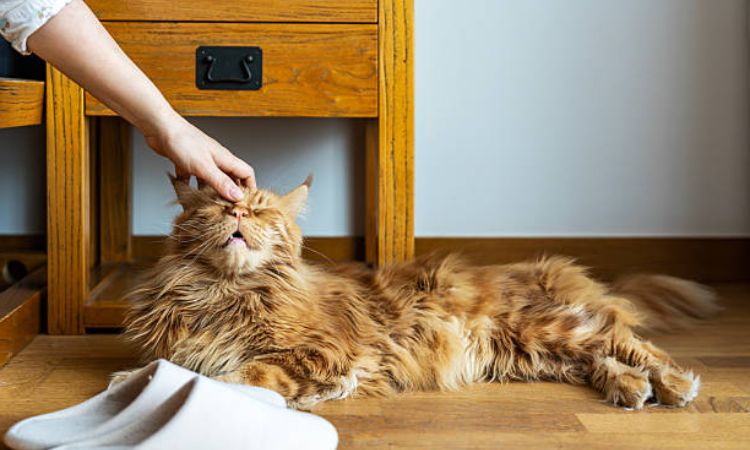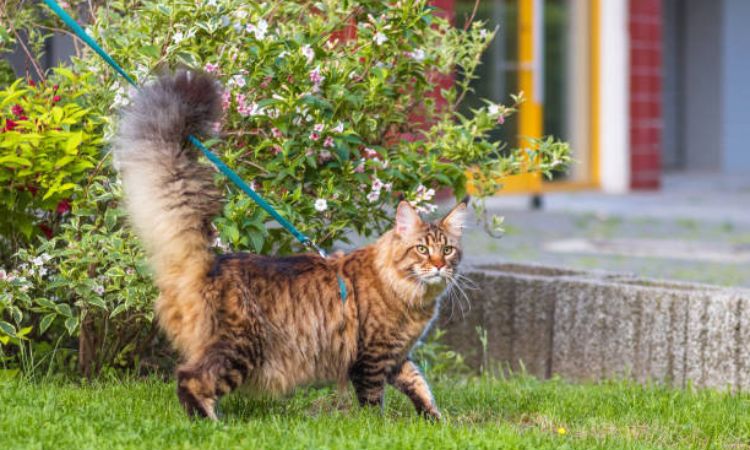With its shaggy coat, tufted ears, and larger-than-life presence, the Maine Coon is less a housecat and more a legend in fur. Hailing from the pine forests and snowy winters of Maine, this “gentle giant” has earned its place as America’s beloved state cat—and one of the most iconic breeds in the world.
Equal parts rugged adventurer and affectionate family companion, the Maine Coon turns heads not just for its size but for its personality that’s every bit as grand.

History and Origin of the Maine Coon
The Maine Coon is one of the oldest and most iconic natural cat breeds in North America, originating from the U.S. state of Maine, where it is also the official state cat. Known as the “gentle giant” of the cat world, the Maine Coon’s history is a fascinating mix of fact, folklore, and myth.
Early Origins
Maine Coons are believed to descend from European cats brought to New England by Puritan settlers in the 1600s–1700s. Phylogenetic studies show they belong to the Western European monophyletic cat branch, closely related to random-bred cats in the northeastern United States. Their similarities with long-haired breeds such as the Norwegian Forest Cat or Siberian Cat are due to convergent evolution—natural selection shaped them for survival in harsh winter climates with thick coats, tufted ears, large paws, and muscular builds.
Popular Myths
Over time, several myths have developed around the Maine Coon’s origins:
- Raccoon Hybrid Myth: A common but impossible myth claims Maine Coons are part raccoon. This is biologically untrue, but it likely arose from their bushy tails and tabby markings.
- Viking Ship Cats: Some suggest the breed descends from cats brought by Viking settlers, linking them to Norwegian Forest Cats.
- Marie Antoinette Story: Another legend claims that the queen’s prized Turkish Angora or Siberian cats were sent to America during her attempted escape from France, eventually breeding with local cats in Maine to form the Maine Coon.
While entertaining, these stories are more folklore than fact; the breed’s true lineage traces back to early European cats adapted to the New England environment.
Rise in Popularity
The Maine Coon first appeared in literary works in 1861, and by the late 19th century, the breed was a favorite at local fairs and cat shows, including the first North American cat show in Boston in 1895. A female brown tabby Maine Coon named Cosey won Best in Show, cementing the breed’s reputation.
In the early 20th century, the introduction of imported long-haired breeds like the Persian led to a decline in Maine Coon popularity. The breed’s survival was aided by local breeders and enthusiasts who formed organizations such as the Central Maine Cat Club in the 1950s to preserve and promote the Maine Coon. By 1976, the breed achieved championship status with the Cat Fanciers’ Association (CFA), and in 1985, it was officially recognized as Maine’s state cat.

Understanding Maine Coon Size and Weight: The Key Facts
The Maine Coon stands out as the largest non-hybrid domesticated cat breed, renowned for its impressive size and rugged, muscular build. Unlike many other cat breeds, Maine Coons are slow to mature, taking anywhere from three to five years to reach their full adult size, which contributes to their reputation as “gentle giants.”
Male vs. Female Size Comparison
- Average Male: 13–18 lbs (5.9–8.2 kg), though exceptional males can weigh 25 lbs (11.3 kg) or more.
- Average Female: 8–12 lbs (3.6–5.4 kg).
Length and Height
- Length: Maine Coons measure 19–40 inches (48–102 cm) from nose to tail tip, with their long, bushy tails adding to their overall grandeur.
- Height: From paw to shoulder, adults typically stand 10–16 inches (25–40 cm) tall, giving them a broad, rectangular frame that supports their hefty weight.
This combination of length, height, and muscular structure not only distinguishes Maine Coons from average domestic cats but also equips them for survival in harsh climates, making them one of the most robust and majestic breeds in the feline world.

Debunking Common Myths About the Breed
Myth #1: The Raccoon Ancestry
One of the most widespread myths surrounding the Maine Coon is the idea that it is somehow a hybrid between a cat and a raccoon. While the breed’s long, bushy tail may resemble that of a raccoon, this notion is scientifically impossible. Maine Coons are purely domestic cats, with genetic studies tracing their lineage to cats brought to New England by European settlers, likely including influences from Norwegian or Siberian Forest cats. The raccoon story remains a charming piece of folklore, but it has no basis in reality.
Myth #2: They Are Always Record-Breakers
Although Maine Coons are among the largest domestic cats, not every individual will set a world record. Exceptional cats like Stewie, who measured 48.5 inches from nose to tail tip, and Barivel, measuring 44.1 inches, have made headlines for their extraordinary length. These cases are rare; most Maine Coons fall within the typical size range of 13–18 lbs for males and 8–12 lbs for females, with lengths between 19 and 40 inches. While impressive, these cats are not guaranteed to break records—they are simply naturally large, robust animals.
Myth #3: All Large Cats Are Maine Coons
Not every large domestic cat is a Maine Coon. Other breeds, such as the Norwegian Forest Cat and the Ragdoll, also reach substantial sizes, but their body structure, coat texture, and personality traits differ. Maine Coons are distinguished by their rectangular bodies, broad chests, tufted ears, and thick, water-resistant double coats designed for survival in harsh climates. Understanding these distinctions ensures prospective owners can identify true Maine Coons rather than mistakenly assuming any large cat fits the bill.
What to Know Before You Buy: Essential Buyer’s Guide

The Commitment to “Gentle Giants”
Maine Coons aren’t just cats—they’re majestic companions with dog-like personalities. Known for their playful, intelligent, and social nature, they thrive on interaction with their human family members. While they may not always be lap cats, these gentle giants often follow their owners from room to room, participate in family activities, and communicate with unique chirps, trills, and soft purrs.
Because of their size and energy, Maine Coons require:
- Ample space to roam: These cats are large and benefit from areas where they can stretch, jump, and climb freely.
- Enrichment and interactive toys: Puzzle feeders, climbing trees, and regular play sessions help keep their minds stimulated and prevent boredom.
- Consistent attention: While independent at times, they enjoy companionship and can become bored or lonely if left alone for long periods.
Owning a Maine Coon is a long-term commitment—these cats can live 12–16 years with proper care, meaning your home, schedule, and resources must be ready for a lifetime companion.
Financial Considerations
Maine Coons are not just big in personality—they come with a bigger price tag and ongoing costs:
Initial Costs:
- Purchasing a Maine Coon kitten from a reputable breeder typically ranges from $1,000–$3,500, with top show lines reaching $4,000–$6,000.
Ongoing Costs:
- Food: Larger cats eat more. Expect to invest in high-quality, protein-rich diets that support their growth and health.
- Veterinary Care: Regular checkups, vaccinations, spay/neuter, and preventive care are essential. Genetics testing for HCM, SMA, and hip dysplasia may also be recommended.
- Grooming Supplies: While their double coats are mostly self-maintaining, Maine Coons require weekly brushing, occasional bathing, and nail trimming.
Over a full year, expenses—including food, litter, toys, insurance, and vet care—can easily reach $2,000–$3,000+. Planning ahead for these costs ensures your Maine Coon stays happy and healthy.
Finding a Reputable Breeder
Choosing the right breeder is critical to ensure your kitten is healthy and well-adjusted. When evaluating a breeder, consider asking:
- Health Screenings: Are the kitten’s parents tested for common genetic conditions such as Hypertrophic Cardiomyopathy (HCM), hip dysplasia, or SMA?
- Living Conditions: Can you visit or see photos/videos of the kitten’s living environment? Healthy, social kittens are raised in clean, stimulating spaces.
- Kitten Age: Is the kitten at least 12 weeks old before going home? This is crucial for proper socialization and development.
- Health Guarantees & Contracts: Does the breeder provide written guarantees for the kitten’s health and a contract outlining responsibilities and expectations?
A responsible breeder will not only provide documentation and testing results but will also be knowledgeable and willing to answer your questions.
Adoption as an Alternative
For those open to adopting, Maine Coon rescue organizations exist and often have kittens or adult cats in need of loving homes. Adoption can be a rewarding alternative, allowing you to provide a second chance for a cat in need while still enjoying the unique personality and charm of this gentle giant breed.
Maine Coon cats are truly remarkable companions, blending impressive size with gentle, playful personalities. Understanding their growth, grooming needs, and health considerations ensures you can provide the space, care, and attention they deserve. Being informed before bringing one home sets the stage for a rewarding and lasting bond with these gentle giants.






